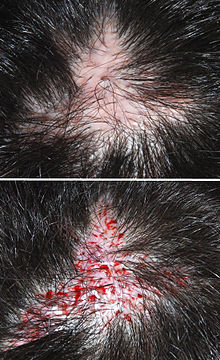Criticism
Mesotherapy treatments have been performed throughout Europe, South America, and more recently the United States for over fifty years. However physicians have expressed concern over the efficacy of mesotherapy, arguing that the treatment hasn't been studied enough to make a determination. The primary issue is that mesotherapy for the treatment of cosmetic conditions hasn't been the subject of gold standard clinical trials; however the procedure has been studied for the pain relief of other ailments, such as tendonitis, tendon calcification, dental procedures, cancer, cervicobrachialgia, arthritis, lymphedema, and venous stasis.[3] Further, there have been case series and numerous medical papers on the mesotherapy as a cosmetic treatment, as well as studies that employ the ingredients used in mesotherapy.[4][5]
The other side of the debate is expressed by Rod Rohrich, M.D., Chairman, Dept. of Plastic Surgery, University of Texas Southwestern Medical Center, Dallas: "There is simply no data, no science and no information, to my knowledge, that mesotherapy works." The American Society of Plastic Surgeons issued a position statement not endorsing mesotherapy, but this non-endorsement is the subject of some controversy. Since mesotherapy isn't a surgical treatment but, rather, a non-invasive alternative to plastic surgery, the treatment competes with plastic surgery for the same patients.
The FDA cannot control the use of practitioners injecting various mixtures into patient's bodies because this practice falls under the jurisdiction of state medical boards. This is the case because the mesotherapy is considered a "procedure" by state medical boards. The FDA, on the other hand, is mandated to approve foods, dietary supplements, drugs, vaccines, biological medical products, blood products, medical devices, radiation-emitting devices, veterinary products and cosmetics.
Dr. Robin Ashinoff, speaking for the American Academy of Dermatology, says "A simple injection is giving people false hope. Everybody's looking for a quick fix. But there is no quick fix for fat or fat deposits or for cellulite." The American Society for Dermatologic Surgery informed its members in February 2005 that "further study is warranted before this technique can be endorsed."
Many dermatologists and plastic surgeons are alarmed about the growing profile of mesotherapy. "No one says exactly what they put into the (syringe)," says Naomi Lawrence, a derma-surgeon at the University of Medicine and Dentistry of New Jersey. "One drug they often use, phosphatidylcholine, is unpredictable and causes extreme inflammation and swelling where injected. It is not a benign drug." USAToday 8/4/2004.
It is currently banned in a number of South American countries. Even Brazil, which is less strict than the USA in drug approvals, has banned the drug for these purposes. USAToday 8/4/2004.
In Australia, an alternative therapy salon is being investigated by the Health Department after several clients developed skin abscesses on the calves, buttocks, thighs, abdomen, shoulders, face and neck from the treatment, with one patient also developing a mycobacterial infection

